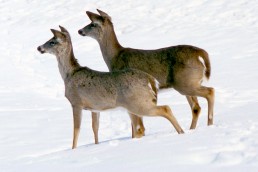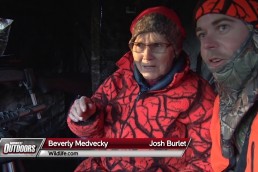And You thought Your Mother had Good Ears
SHARE THIS POST
My first lesson in noise control was appropriately during my first year hunting. I kept hearing a squirrel behind me and finally, after about the hundredth time of turning around to see if it was a deer, I learned to ignore it. After an eternity of holding my temper and stopping myself from jumping up and throwing my bow, I realized that there was a different sound coming from behind me but at a slightly different angle. I slowly peeked around the trunk of the maple.
The deer was already looking right at me.
I eased my head back and waited for a count of 50. Another look—but she was long gone. I leaned back and thought through what had just happened. The deer could not have smelled me, as it was upwind. It couldn’t have seen me because the trunk of the maple covered my shoulders and she was already looking at me before I had eased my face around the trunk. So that left only noise as the last of the big three no-no’s to account for. I redid my movement, and sure enough as I pivoted around, the rubber of my boot squeaked ever so slightly. I could barely hear it, but it was certainly enough to alert that doe to my presence.
My second lesson about noise was nearly the opposite. I was attempting to stalk up on some bedded does. I was within about 40 yards when I stepped into a soft spot and tumbled into the brambles. I laid still for several dozen heartbeats. I slowly raised my head believing that the deer would be long gone. But to my surprise, they were still just laying there, not even looking in my direction. My fall was so quick, and because I had lain very still, they were not sure what had made the noise. I spent a couple of minutes laying there trying to think of a way to get up quietly. Since I was on my back, I couldn’t jump up and get a quick shot. I levered myself up on one elbow. That was enough to have them both look right at me. I knew I was busted. I decided the best course of action then was to just stay low and scramble around hoping that they would at least think I was a raccoon or other animal. That seemed to work, as they moved slowly away so they probably didn’t know if I was hunter.
People talk about the silence of the woods. Well it isn’t. Leaves, squirrels, birds, trees falling and more add their voice to the symphony of the forest. When you walk you cannot help but make some sounds. Even with the softest of steps, new fallen leaves crackle, an unseen twig will snap, your clothing will brush against a twig, etc. If deer reacted to every sound as if it were a threat, they would soon kill themselves with running hither and yon. Think of a party. When you try to listen to every conversation you hear none of them. So, you ignore those who don’t interest you. Deer learn early on which sounds to ignore and which sounds to key in on. Hunting is not eliminating noise, but making that noise fit into the normal background. That starts from the moment you drive up to your hunting area. Deer are use to hearing farm machinery and cars on the road, but a closing door means a human is getting out of a car and that means danger. As you walk to your stand remember that you are not walking on a sidewalk. We are programed to step heel-to-toe and to get here to there as quickly as possible. No creature moves in a steady, straight line. They all do a move-stop-move-hold-type of motion. This allows them to look around and see if there are any threats, find food or deer. A better way to step is “ball” than “heel.” This technique lets you feel any twigs that might snap underfoot, and, unlike standing on your heel, it helps you keep your balance if you have to adjust your foot to a different position. It also forces you to think about your steps since you are doing something that is not quite natural to you. Finally, it makes you walk slower even to the point of mimicking the move-stop-move-hold motion.
The right sound at the right time is also important. Dawn and dusk are the noisiest times of the day; everything is getting up or coming home. This is the best time to blend into the general background noise. I long ago gave up walking to my stands in the dark. First, it is easy to get lost. Second, no creature is moving very quickly in the dark so you are that much more conspicuous. Even with nocturnal eyes of deer, they cannot see as much or as far, and therefore that much more alert. You also cannot see anything so you are more likely to spook a deer either by stepping on a twig, or even worse, using a flashlight.
Are you enjoying this post?
You can be among the first to get the latest info on where to go, what to use and how to use it!
It has been suggested that you should get into your stand at least an hour before first light and not leave until well after dark. There is probably some validity to this. The hypothesis being that deer will be in the fields eating so you will not spook them in your bumbling trek through the woods. The problem with this is that we have problems enough staying on stand for a full day and now you have added two or three more hours to squirm, fidget or make a mistake. Noon on the other hand is quiet time and then most are taking a siesta. Deer and other prey animals have learned that staying still is the easiest way to conserve energy—not be seen and to see others. Your motion is that much more apparent since you are the only thing moving. So when should you get to your stand be quiet as possible.
So how do can you reduce or eliminate extraneous noise?
Start first with your clothing and equipment. Clothing should be as “quiet” as possible. Cabela’s Xtreme Silent Tech or ScentBlocker’s Dream Season and most anything of wool will keep you quiet from inadvertent encounters with twigs. After being relegated to old-timer’s long johns, wool is making a comeback not only for its insulating properties, but also for its silent aspects. Remove all hook-and-loop fasteners, including Velcro. Replace all with an elastic loop and button system. Choose buttons over zippers for the same reason. For many years I wore regular boots, but now I have switched to ScentLok’s Silent Stalk Sneakers. They have a thin rubber sole that gives me arch support yet I still feel what is under my foot. In cold weather, I just carry a set of overboots to slip on while I am on stand.
For equipment, rattle and shake everything. Tighten screws and use moleskin where parts touch. Use dry lubricant on moving parts. I do not like a quiver on my bow since it is one more thing that can catch a branch. Instead, I use a back quiver that is slung low enough so that the fletching’s are situated right behind my head and shoulder. On stand it is slung in easy reach next to my shooting hand. I also carry only three arrows. That gives me one miss and one for a follow-up kill shot if needed and I figure that if I miss twice I need to go home.
We all need snacks and water while setting in a treestand. Only take “silent” food such as raisins, bananas and sandwiches without lettuce. Pre-wrapped snacks get unwrapped at home and placed in a sandwich bag. Water should be in a hard container that has been wrapped in camo cloth tape. Although this hint has more to do with sight, all my equipment is taken out of my fanny pack and placed within easy and with the lowest motion to reach it.
Not many hunters are completely silent and if you do make noise you have to blend into the natural background of the environment. Learn the natural sounds of your hunting area and mimic them whenever possible to have more success.
MWO
SHARE THIS POST
Did you enjoy this post?
You can be among the first to get the latest info on where to go, what to use and how to use it!
Doug Thalacker
Doug Thalacker has a Masters of Environment Science from UW-SP and taught high school environmental science and earth science. He has outdoor/wilderness training through Outward Bound and American Red Cross. He has a lifetime of enjoying any activity that involves fields, woods or waters.



